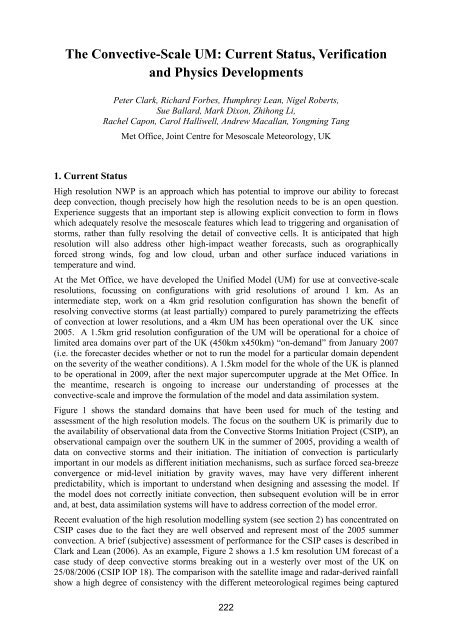Proceedings - C-SRNWP Project
Proceedings - C-SRNWP Project
Proceedings - C-SRNWP Project
You also want an ePaper? Increase the reach of your titles
YUMPU automatically turns print PDFs into web optimized ePapers that Google loves.
The Convective-Scale UM: Current Status, Verification<br />
and Physics Developments<br />
Peter Clark, Richard Forbes, Humphrey Lean, Nigel Roberts,<br />
Sue Ballard, Mark Dixon, Zhihong Li,<br />
Rachel Capon, Carol Halliwell, Andrew Macallan, Yongming Tang<br />
Met Office, Joint Centre for Mesoscale Meteorology, UK<br />
1. Current Status<br />
High resolution NWP is an approach which has potential to improve our ability to forecast<br />
deep convection, though precisely how high the resolution needs to be is an open question.<br />
Experience suggests that an important step is allowing explicit convection to form in flows<br />
which adequately resolve the mesoscale features which lead to triggering and organisation of<br />
storms, rather than fully resolving the detail of convective cells. It is anticipated that high<br />
resolution will also address other high-impact weather forecasts, such as orographically<br />
forced strong winds, fog and low cloud, urban and other surface induced variations in<br />
temperature and wind.<br />
At the Met Office, we have developed the Unified Model (UM) for use at convective-scale<br />
resolutions, focussing on configurations with grid resolutions of around 1 km. As an<br />
intermediate step, work on a 4km grid resolution configuration has shown the benefit of<br />
resolving convective storms (at least partially) compared to purely parametrizing the effects<br />
of convection at lower resolutions, and a 4km UM has been operational over the UK since<br />
2005. A 1.5km grid resolution configuration of the UM will be operational for a choice of<br />
limited area domains over part of the UK (450km x450km) “on-demand” from January 2007<br />
(i.e. the forecaster decides whether or not to run the model for a particular domain dependent<br />
on the severity of the weather conditions). A 1.5km model for the whole of the UK is planned<br />
to be operational in 2009, after the next major supercomputer upgrade at the Met Office. In<br />
the meantime, research is ongoing to increase our understanding of processes at the<br />
convective-scale and improve the formulation of the model and data assimilation system.<br />
Figure 1 shows the standard domains that have been used for much of the testing and<br />
assessment of the high resolution models. The focus on the southern UK is primarily due to<br />
the availability of observational data from the Convective Storms Initiation <strong>Project</strong> (CSIP), an<br />
observational campaign over the southern UK in the summer of 2005, providing a wealth of<br />
data on convective storms and their initiation. The initiation of convection is particularly<br />
important in our models as different initiation mechanisms, such as surface forced sea-breeze<br />
convergence or mid-level initiation by gravity waves, may have very different inherent<br />
predictability, which is important to understand when designing and assessing the model. If<br />
the model does not correctly initiate convection, then subsequent evolution will be in error<br />
and, at best, data assimilation systems will have to address correction of the model error.<br />
Recent evaluation of the high resolution modelling system (see section 2) has concentrated on<br />
CSIP cases due to the fact they are well observed and represent most of the 2005 summer<br />
convection. A brief (subjective) assessment of performance for the CSIP cases is described in<br />
Clark and Lean (2006). As an example, Figure 2 shows a 1.5 km resolution UM forecast of a<br />
case study of deep convective storms breaking out in a westerly over most of the UK on<br />
25/08/2006 (CSIP IOP 18). The comparison with the satellite image and radar-derived rainfall<br />
show a high degree of consistency with the different meteorological regimes being captured<br />
222

















